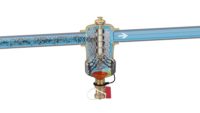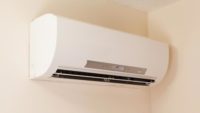When I first entered the trades in 1972, residential tank-style water heaters shipped with the aquastat set to approximately 140° F. Dishwashers had no need to incorporate a sanitizing cycle. Around 1977, water heater manufacturers were required to lower the aquastat temperature setting to approximately 120°, and now, dishwashers needed to incorporate a sanitizing cycle where rinse water in their reservoir was raised to 140° or higher.
We found out — the hard way — that replacing a 40-gallon tank water heater with another same-sized model suddenly resulted in customer complaints due to running out of hot water. The lower water storage temperature resulted in a larger volume of hot water utilized for the final mixed water temperature in the bathing module. Given that the aquastat is easily adjusted to raise the stored water temperature, many consumers did that on their own. With the good intention of lowering the water temperature to reduce the thermal scald injuries and deaths, the end result over the ensuing years was there had not been a reduction in thermal scalding cases. Instead of 40-gallon water heaters, we upgraded to 50-gallon models to provide similar performance without raising the storage temperature. From our perspective, our resetting the aquastat to provide hotter water was a serious liability issue. Ignorance was bliss, but not for long because other dangers lurked.
A not-so-funny thing happened on the way to the forum. The forum being a mechanical contracting website: Area51HVAC.com. I was asked to provide an online presentation and chose what was, and still remains, a controversial subject: Utilizing water heaters for both hydronic heating and potable hot water. I’m talking open direct cross-connected hydronic and potable water, which never made good common sense to me, and while researching the subject, I ran smack head-on into Legionella and bacterial amplification. As it turned out, tank-style water heaters and storage vessels for DHW were already recognized as bacterial amplifiers. To say I was stunned would be a gross understatement, but even more astounding was the fact that virtually no one in the mechanical trades was talking about the issues. That night’s forum darn near crashed the Area51HVAC website! Following that, I began writing articles regarding scalding and Legionella bacteria amplification within our potable DHW systems, and let’s just say I was met head-on with dramatic pushback from manufacturers and contractors. The further I dug into the issues, the more evidence surfaced that clearly illustrated the correlation between lower water temperatures and bacterial amplification in potable DHW systems. Today, most folks understand there are issues that can be easily addressed.
Legionella bacteria reproduction slows as DHW temperatures rise above 113°, but don’t essentially stop until you attain 133°.
Legionella bacteria need just a few conditions for rampant reproduction — water temperatures between 50° to 113°, with 98.6° being ideal, which is why human lungs offer an excellent opportunity; pH of 5.5 to 8.0, which the majority of our potable water systems provide; biofilms, which occur naturally within potable water distribution networks; sediment, scale and sludge, which we find in the base of storage vessels; and stagnation, which occurs in dead legs (largely unused portions of potable water systems (applies to both hot and cold water lines). Legionella bacteria reproduction slows as DHW temperatures rise above 113°, but don’t essentially stop until you attain 133°.
Potable DHW systems can be treated in one of two ways with elevated storage temperatures of 135° or greater: Install an ASSE- listed thermostatic scald guard valve to reduce the water temperature at the storage vessel’s outlet to 120° as is required per our plumbing codes and what plumbing inspectors check for at an unprotected point-of-contact (typically a lavatory faucet); or allow full temperature potable water to enter the distribution network while installing ASSE-listed thermostatic scald guard valves nearby the various points-of-use where human contact will be present. The lone issue remaining is stagnation and that can be addressed by incorporating circulation of the potable hot water to the far reaches of the hot water distribution and return to either connect at the storage vessel’s cold-water inlet or connect at the base of the tank where the drain valve is located.
Bathing module faucets have been required to incorporate ASSE-approved scald-guard protection for the past several decades. Most are pressure-balancing models, which are blind to fluctuating municipal cold water temperatures. The installer must set the final stop on the mixing and, here again, the inspector is looking for a maximum of 120° delivered. The average human threshold for pain is 108°, and plumbing for the elderly in retirement and/or nursing homes mandates a maximum DHW delivery temperature of 110° – providing Legionella with a perfect invitation. There are also thermostatic tub/shower valves, but they can be subject to sudden pressure imbalances. The ideal tub/shower valves incorporate both pressure and temperature balancing.
Thermal stacking in DHW storage vessels is also an issue often ignored and/or overlooked. ANSI Z21.10.1 governing DHW for 75,000-Btu/h or less recognizes the stacking issue and allows for a 30° increase above the factory 120° setting. That code-compliant layer of 150° can cause a third-degree burn in one 1-second or less. Infants and the elderly have a much thinner dermis skin layer rendering them more susceptible to dangerous thermal scald damage.
My preference has been to maintain 135° to 140° thermal storage temperatures for DHW vessels, constant recirculation of DHW (yes, I understand this would violate California energy code), and scald-guard protection at all points-of-use with a few exceptions: Washing machines, dishwashers and points-of-use (example: Commercial kitchen pre-rinse sinks) where elevated water temperatures are required.
As we have done for both residential and commercial applications, my home’s indirect water heater maintains 135° to 140° storage temperatures with 24/7 constant hot water circulation leaving as 1-inch copper and returning via 1/2-inch copper with the 175-foot loop fully insulated, scald-guard pressure and temperature ASSE-listed scald-guard valves and ASSE-listed thermostatic scald-guard valves for the majority of our points-of-use. The lavatory faucets delivery DHW temperature is set to 110°. The DHW loop passes by just a few feet from all fixtures utilizing DHW (to minimize potential bacterial growth sites).
Still thinking that 120° is a safe DHW temperature? According to the Moritz and Henriques studies on thermal scald times, 120° DHW provides a third-degree burn in just 9.3-minutes for healthy adults and 3.1 minutes for children. Remember that those times will be shorted for infants and the elderly. However, at 110°, it takes 6.7 hours for adults and 2.8 hours for third-degree scalds to occur.
Sadly, our national plumbing codes do not adequately address DHW scalding issues for all points of contact where folks are left exposed to this danger. Until they do, there will continue to be well over 100,000 scalding incidents occurring in the USA each year, and it remains our responsibility (as installers and specifying engineers) to educate our customers while offering installations that incorporate adequate protections.
Dr_Microbe/iStock/Getty Images Plus via Getty Images.




